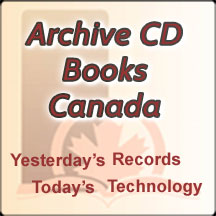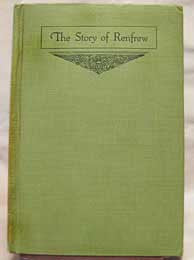The Story of Renfrew from the coming of the First Settlers about 1820, Vol. 1. Pub. 1919 (on CD)
Cat No.: CA0430: (See also product CA0430-DL for this "book" as a downloadable file and save the mailing cost.)
The story behind the creation of this book is almost as interesting as the story of Renfrew itself. In fact the two stories are intertwined, the primary author, W. E. Smallfield, being the area's newspaper publisher and oft-times its political representative. Suffice it to say that it took almost 20 years (and a stand-in author: Rev. Robert Campbell), in its preparation. By that time sufficient additional material had been collected to bring the original author to think that he could write a further book, a volume 2 to this one. This second volume was never published, however, leaving this volume declaring itself, Volume 1 of one! The book takes many of its stories from "locals" who were either original settlers or were the offspring of their families. By the time the book was published portions of it had already appeared in the local newspaper - the same company which eventually undertook its publication, printing and distribution.
The book opens with a picture gallery of people whose names are forever joined with Renfrew, either because of their pioneering activities or because of their contributions to its growth and success.
The explosive growth of the lumber industry in the Ottawa Valley above Ottawa, can be credited with the initial establishment of Renfrew as a settlement site. The lumbering industry bought many workers to the forests on the banks of the Ottawa and any tributary large enough to carry logs to it. But this was not an industry which naturally encouraged settlement, the work continuously moving to seek out new supplies of trees, and being mainly seasonal, i.e., when the ground was hard enough to carry the weight of the felled logs as they were dragged to the river. Not, that is, until about 1820 when one man decided to set up homesteading on the Bonnechere (or Good) river, instead of heading back down river at the end of the winter’s lumbering season.
The publication date of this book is 1919 but there are few stories of the last 20 years, since the majority of the initial growth spurt was contained in the 1820 − 1900 years, still the claim to carrying the “story” of Renfrew remains a valid one. Also, while the story initially concentrates only on the village of Renfrew its scope expands to include the other surrounding villages and townships as they became established and eventually became recognized as the independent County of Renfrew.
The initial paragraphs concentrate on the “Early” settlers and are gathered by topic and/or by decade. Topics are as diverse as “The Early Churches and Preachers” “Early Lumberers” and “Efforts to Secure Railway Communications.” One thing which was consistently reported throughout is the names of individual citizens involved in all these activities and it seems as if almost every family in the area must have been mentioned as being involved in some form of activity. The book also provides an Index of Names which further assists in finding mentions of particular individuals.
The authors seem to consider that this “Early” period terminated at about 1850 because they seem to move from attempting to chart the entire gamut of town-building, to recording just individual stories of the area - in a more or less chronological order - but more like dipping into the multiplicity of stories of the area’s progress. We wonder if much of this information may have come directly from the files of the newspaper which originated from the same source, so the book becomes more of a compendium of incidents in the area’s history than a formalized, all encompassing, history. In many ways this change of style allows a more intimate insight into the detail of Renfrew’s growth, and is closer to how the original inhabitants would have learned their own story. Unfortunately, at the same time it makes very difficult to describe the whole field of information provided, so we have resorted to picking out a few random examples in order to illustrate the breadth of the topics reported:
Patriotic Funds of the Crimean War —The method of licensing taverns — Choosing the municipal motto — The early Church socials — Council converts Mechanics' Institute into Free Public Library — Renfrew's First Lock-up — Appeal for telegraph communication — John Burns appointed Treasurer —Hand fire-engine purchased — Proposition for planting of shade trees — B. J. McDermott as policeman — Bylaw prohibiting cows from running at large all year — First Deputy-Reeve chosen — The Voters at Renfrew's First Municipal Election — The County Council
This is an intimate and engaging look at the development of Renfrew as a Settlement, a Town, a Township, and now, as a County. Our digital reproduction brings you clear images of the pages of the original book* as they were printed, but under-laid with high accuracy OCR’ed text to allow computer-searches, speed enhanced by the use of our FastFind technology.
* The original of this book was printed by the newspaper company owned by the primary author, and it took place over a number of years. The book even includes a statement to the effect that three different printing technologies were employed in its production. It is not surprising then that the printing quality is closer to that of a newspaper than that usually expected of a book, i.e., intended to survive many detailed readings. not just one glance and then to be “recycled.” Nor was the binding technology employed much better making reading somewhat physically uncomfortable. In a newspaper the publisher can “get away” with many production “liberties” because of the astonishing ability of the Human “eye” to compensate for such shoddy work. Unfortunately computers do not have this innate capability, so we had to carry out extensive digital editing of the page images of this book, and then further hand correct the OCR’ed product, to obtain our required accuracy of text recognition. We suspect that this will be the first time that the text of this book is fully open to computer searching, an important facility in a document having a somewhat random inclusion of personal reference, and an equally chaotic organization of content.
No. of CDs is: 1 ; Format is: PDF ; Searchable?: YES;
FastFind: Yes; ISBN No.: 978-1-927503-44-7 ;


